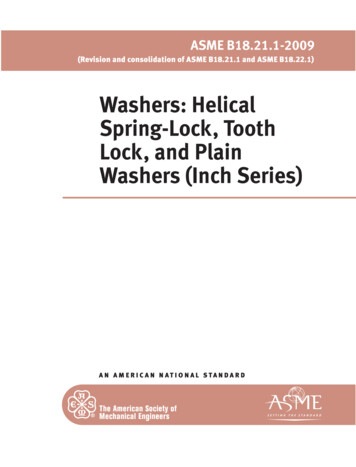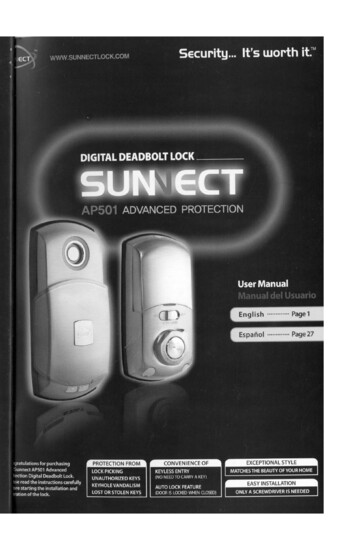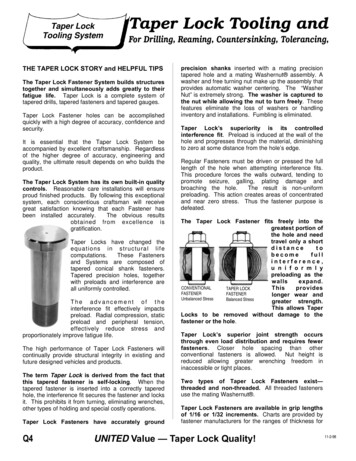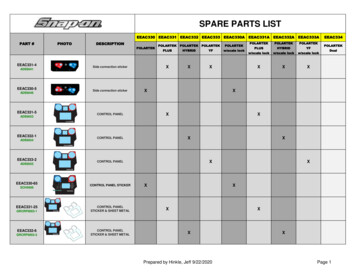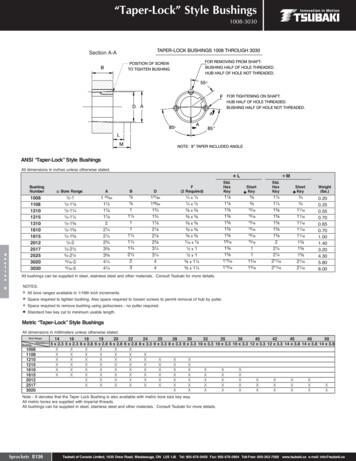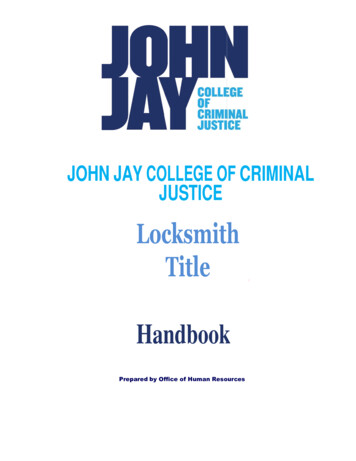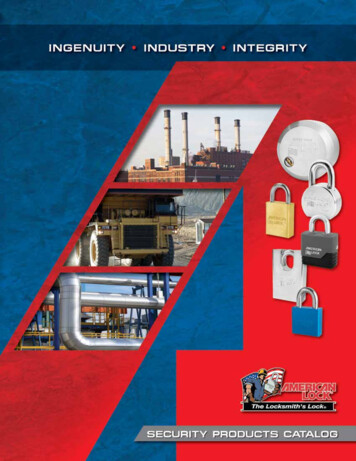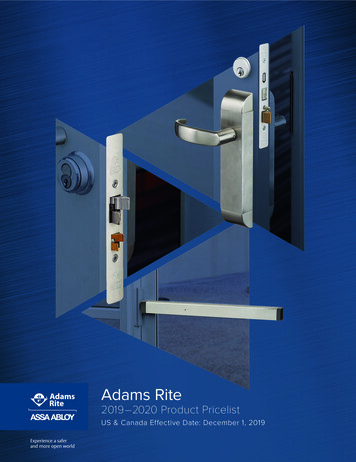
Transcription
Key (lock)Azhar26-03-2016
A key is a device that is used to operate a lock (such as tolock or unlock it).It consists of two parts: the blade, which slides into the keyway ofthe lock and distinguishes between different keys, and the bow,which is left protruding so that torque can be applied by the user.BladeParts of a keyA key is usually intended to operate one specific lock or a smallnumber of locks that are keyed alike, so each lock requires a uniquekeyKey is a method of access control for access to physical propertieslike buildings, vehicles and cupboards or cabinets and as such anessential feature for modern living.
History:The earliest known (around 4000 B.C.) lock and key device was discovered inthe ruins of Nineveh, (now Iraq).They were developed into the Egyptian wooden pin lock, which consistedof a bolt, door fixture,Egyptianand key. Lock MechanismThe key is inserted into thelock bolt, and the pins areliftedThe key is then pulled out ofthe lock along with thedeadboltThe first all-metal lock appeared between the years 870 and 900,and are attributed to the English craftsmen.It is said that the key was invented by Theodore of Samos in the 6thcentury BC.Onset of industrial revolution lead to the manufacture of locks and keys withincreasing complexity and sophistication.
key operates in the opening of a lock:
Types:Pin tumbler lock keyA pin tumbler lock key is the most common key. There is a series of pointed teethand notches on the blade called bittings which allow pins or wafers to move up anddown until they align with the shear line of the inner and outer cylinder, to rotatefreely inside the lock, which opens the lock.Lever lock keyA lever lock is made up of a set of 'levers'. The teeth or bittings of the key have flattops rather than being pointed. Once all the levers have been moved to the correctheight, the locking bolt is free to slide across and secure the door.Tubular keyA tubular key (sometimes referred to as a ace, radial or barrel key) has a hollow,cylindrical shaft that is usually much shorter and has a larger diameter than mostconventional keys. Tubular keys are commonly found on vending machines,launderettes, bike locks etc.Internal cut keyAn internal cut (also known as "Sidewinder" or "Laser Cut") key has a rectangularblade with a wavy groove cut up the center of the face of blade, at constant depth.Typically the key has an identical wavy groove on the back of the blade, making it
ther types of KeyDouble-sided keyIt has two sets of teeth, an upper level standard set of teeth and a lower, lessdefined set of teeth beside it. This makes the double-sided key's profile and itscorresponding lock look very similar to a standard key while making the attempt topick the lock more difficult.Abloy keyAbloy keys are cut from a metal half-cylinder. The cuts are made at differentangles, so when the key is turned in the lock it rotates each disk a differentamount. Nearly all the houses in Finland use Abloy keys. These locks areconsidered very secure and almost impossible to pick.Dimple keyA dimple key has a rectangular blade with various cone-shaped dimples drilled intothe face of the blade at various depths. Typically the lock has 2 rows of pins thatmatch up with 2 rows of dimples. Typically the key has the same dimple pattern onthe back of the blade, making it symmetrical so it works no matter which way it isinserted.
Zeiss keyA Zeiss key (also known as a Cruciform key) is a cross between a house key and atubular key. It has three sets of teeth at 90 degrees to each other with a flattenedfourth side. Though this type of key is easy to duplicate, the extra sets of teeth deterlockpicking attempts.MagnetickeyA magnetic keyed lock is a locking mechanism whereby the key utilizes magnets aspart of the locking and unlocking mechanism. This is a totally passive systemrequiring no electricity or electronics to activate or deactivate the mechanism. Usingseveral magnets at differing polarity / orientations and different strengths can allowthousands of different combinations per key.
Digital Keys:Keycard A keycard is a flat, rectangular plastic card with identicaldimensions to that of a credit card or driver's license that storesa physical or digital signature that the door mechanism acceptsbefore disengaging the lock. There are several popular type of keycards in use including themechanical holecard, bar code, magnetic stripe, Wiegand wireembedded cards, smart card (embedded with a read/writeelectronic microchip), and RFID proximity cards. Keycards are frequently used in hotels as an alternative tomechanical keys. New smart lock technologies are graduallyintegrating and bringing keycard technology to smartphones.Smart key A smart key is an electronic access and authorization systemwhich is commonly available as an option or standard in several
ey systems:Individually keyed system (KD)With an individually keyed system, each cylinder can be opened by its unique keKeyed alike (KA)This system allows for a number of cylinders to be operated by the samekey. It is ideally suited to residential and commercial applications such asfront and back doors.Common entrance suite / Maison keying (CES)This system is widely used in apartments, office blocks and hotels. Eachapartment (for example) has its own individual key which will not open thedoors to any other apartments, but will open common entrance doors andcommunal service areas.Master keyed (MK)A master key operates a set of several locks. Usually, there is nothingspecial about the key itself, but rather the locks into which it will fit.These master-keyed locks are configured to operate with two, or more,different keys: one specific to each lock (the change key), which cannotoperate any of the others in the set, and the master key, which operatesall the locks in the set. Locks that have master keys have a second set ofthe mechanism used to operate them that is identical to all of the othersin the set of locks. For example, master keyed pin tumbler locks often
Thank you
the lock and distinguishes between different keys, . pick the lock more difficult. Abloy keys are cut from a metal half-cylinder. The cuts are made at different angles, so when the key is turned in the lock it rotates each disk a different . A Zeiss key (also known as a Cruciform key) is
